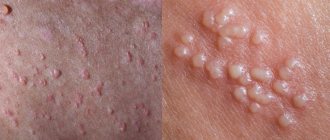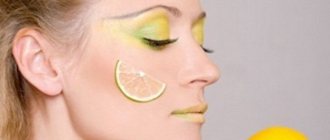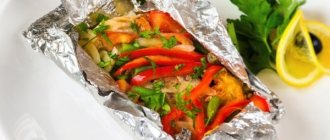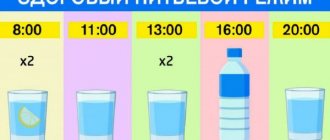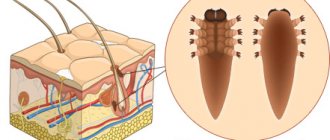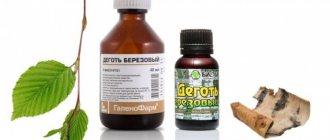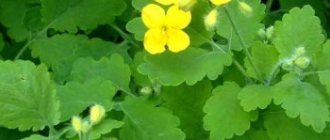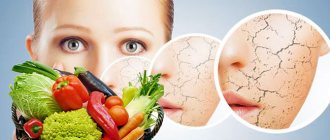For treatment and remission, the correct diet for psoriasis is simply necessary, since it is very important to know what you can and cannot eat with psoriasis, and a diet table for psoriasis, which lists the necessary foods and vitamins for nutrition, will help us with this.
The basis of the diet if you have psoriasis is to maintain the acid-base balance in the body. Moreover, the alkaline reaction should be much greater than the acidic one.
Therefore, the daily diet of foods for psoriasis should consist of 65-75% alkali-forming foods and 25-35% acid-forming foods. Vegetables and fruits are primarily alkali-forming. Acid-forming foods include foods containing starch proteins, fats and oils - meat products, grains, cream, cheese, potatoes.
First of all, nutrition for psoriasis involves drinking a lot of water; you need to drink 7-10 glasses of it per day. It's even better to drink only purified distilled water and freshly squeezed juices.
Nutrition for psoriasis: what are its features?
It is believed that important prerequisites for the development of psoriasis are metabolic disorders, improper functioning of the gastrointestinal tract, intestinal imbalance and dietary errors. Therefore, it is extremely important to take a responsible approach to creating a menu that will provide the body with the necessary vitamins, minerals and nutrients. In addition, proper nutrition for psoriasis implies an increase in the body's defenses, since a strong immune system copes better with the factors that provoke the manifestations of the disease.
The diet for patients with psoriasis involves a number of very strict restrictions. At the same time, it sufficiently supplies the body with the necessary substances and vitamins, and if used correctly, does not affect performance. Therapeutic nutrition for psoriasis is a balanced, proper diet that helps improve your health and increase periods of remission.
Nutrition Basics
It is important for people who suffer from psoriasis to maintain proper nutrition. It will help prolong remission or get rid of the disease altogether. Nutritionists recommend following these tips throughout your life:
- Nutritionists recommend dividing meals into 4-5 meals. You need to eat often, but little by little, to avoid unnecessary stress on the body.
- If you have problems with the gastrointestinal tract, you should abandon potent drugs, giving preference to natural herbal remedies.
- It is necessary to observe the drinking regime. It is recommended to drink at least 2 liters of clean water, as it helps remove toxins from the body faster.
- In addition to water, you can drink herbal infusions and avoid caffeine-containing drinks.
- Vegetables, fruits, and grains are actively introduced into the diet, which contribute to better functioning of the gastrointestinal tract, help maintain ideal body weight, and saturate the body with essential vitamins and minerals.
- When cooking, they prefer boiled, baked, steamed dishes.
These six rules will help the patient forget about disfiguring spots and unpleasant sensations for a long time. What foods should be included in the diet of a patient with psoriasis, and which should be avoided?
Diet for psoriasis: table of foods allowed for consumption
| Allowed | Allowed in limited quantities | Forbidden |
| Foods rich in coarse fiber (fiber). Polyunsaturated fatty acids. Foods rich in calcium and zinc. Vitamins and antioxidants found in fresh fruits and vegetables. Vegetable oils. | Lean meats. Chicken eggs. Sea fish. Dairy and lactic acid products. | Sugar and sweeteners made from it. It is recommended to replace them with stevia and maple syrup. Chocolate. Coffee. Artificial preservatives, dyes, flavor enhancers, flavorings. Nightshade vegetables. Alcoholic drinks. Carbonated drinks. |
Additionally
In case of severe relapses, a patient with psoriasis is indicated for inpatient treatment with an appropriate hospital diet.
At home, during exacerbation of psoriasis, nutrition should be simplified as much as possible:
- eliminate all products from the restricted category (rice, potatoes, eggs);
- temporarily give up meat dishes, giving preference to vegetables and cereals;
- increase the volume of fluid consumed.
Juices should be excluded for a while.
People suffering from psoriasis are offered the original nutrition programs Pegano and Ognevaya. Each of them presents a detailed diet for psoriasis, with an emphasis on foods that promote the formation of alkali in the body. Among doctors there are both supporters of such a diet and opponents. In each individual case, dietary recommendations should be based on the patient’s individual health indicators.
Pegano diet for psoriasis
Dr. John Pegano is an osteopath who has successfully treated skin diseases using the nutritional system he developed. For many years he worked to create an optimal diet to help patients reduce the symptoms of the disease - and he succeeded. John Pegano released a book dedicated to the diet he developed, called “Treating Psoriasis - The Natural Way.” The doctor spoke with her at scientific and popular seminars in different countries, took part in television and radio programs, thanks to which a large number of people learned about his method.
How is the Pegano system fundamentally different from drug treatment of psoriasis? Dr. Pegano was a proponent of the belief that the human body is capable of fighting pathological processes on its own, without the help of drugs. To do this, the patient must comply with certain requirements: eat right, detoxify and have a positive inner attitude.
The main principle of proper nutrition according to Pegano for psoriasis is maintaining an optimal acid-base balance in the blood, which becomes possible through the consumption of certain foods, avoiding junk food and following a diet. According to Pegano, an important prerequisite for the development of psoriasis is excessive blood acidity. Therefore, in the case of eating foods that contribute to alkalization, a noticeable improvement in the patient’s condition is observed. The ratio of alkali-forming and acid-forming foods in the diet menu for psoriasis according to Pegano should be approximately 2:8. That is, 20% of permitted products should account for 80% of mandatory ones.
According to Pegano, the main focus when treating psoriasis with diet should be on fruits, vegetables (except nightshade vegetables), freshly squeezed juices, herbs and clean still water. Despite the fact that some of these foods taste sour (for example, citrus fruits), this should not bother you: once they enter the body, they still increase the alkali content in the blood.
Acid-forming foods should also be present in the diet, but in much smaller quantities. These mainly include protein foods (meat, fish, dairy products, legumes), as well as simple carbohydrates (sweets, refined sugar, potatoes and other starchy vegetables, vinegar).
The food products that are strictly prohibited from an effective diet for psoriasis include alcoholic beverages, coffee, preservatives, carbonated drinks, tomatoes and their juice, eggplants, fried, spicy, salted and smoked foods.
During the diet for psoriasis according to Pegano, the menu for the week should begin with fasting days. Usually, 3-5 days are enough to cleanse the intestines. At this time, you can eat only fruits (usually apples or citrus fruits), supplementing them with enterosorbents. After the specified time has passed, the patient can begin consuming approved products. These include:
- Fresh vegetables and fruits (citrus fruits, watermelon, papaya, mango, melon, grapes, peach, pineapple, garlic, asparagus, spinach leaves, broccoli, parsley, asparagus, celery, zucchini, zucchini, pumpkin, carrots, olives). Please note: do not combine citrus fruits with dairy products or grains.
- Cereals (wild rice, millet, wheat).
- Nuts (almonds).
- Bran.
- Whole wheat bread.
- Vegetable oils (especially olive oil).
- Porridges cooked in water.
- Lean meats (in limited quantities). It is advisable to give preference to lamb, poultry, and sometimes you can eat a small piece of pork.
- Fatty sea fish. Shellfish, crustaceans, and sushi are excluded.
- Dairy and lactic acid products (in limited quantities).
As for the drinking regime, it is advisable to drink about 1.5 liters of pure still water per day, as well as drink freshly squeezed juices, herbal teas, ginger and green tea.
You can start following the Pegano diet for psoriasis only after consulting a doctor. This limitation is explained by the large amount of plant foods and low animal protein content. For example, people who have problems with blood formation or allergies to citrus fruits are not recommended to follow such a diet.
If you really want the therapeutic hypoallergenic diet according to Pegano to help you during psoriasis, you need to not only adhere to the nutritional rules, but also comply with additional requirements. These include stopping smoking, taking medications (except for vital ones), reducing stressful situations and negative emotions, daily rest and relaxation, accompanied by reading your favorite books and listening to soothing music, performing feasible physical exercises aimed at strengthening the spinal column.
As for the duration of this diet, it is advisable to follow it for at least a month - only after this period the first results will become noticeable. If you want to reduce the time of exacerbation of the disease and prolong remissions, it is recommended to adhere to it throughout your life.
Due to its low calorie content and the presence of a large amount of vitamins obtained from fruits, vegetables and juices, following the Pegano diet for psoriasis not only helps reduce the manifestations of psoriasis, but also contributes to the overall health of the body. This nutrition system allows you to adjust your weight, get rid of extra pounds, and also improve your immunity.
Sample menu recommended for patients with psoriasis
An essential part of the diet for psoriasis is to avoid overeating. Despite the strict restriction of consumed products, the patient’s menu can be quite varied.
The diet for nail psoriasis is not too different from psoriasis in other parts of the body. Everything that can cause allergies is removed from the patient’s list of products: caffeine containing, citrus fruits, red fruits and vegetables. Spicy, salty, fatty, smoked, fried foods are also excluded. And the less sauces, mayonnaise, ketchup, the better.
- For breakfast, porridge cooked in water (buckwheat, oatmeal, millet, rice) is recommended. Fruits or dried fruits are added to the porridge. Another breakfast option is low-fat cottage cheese with the addition of yogurt and berries, or a cottage cheese casserole, or a steamed omelet. A healthy drink would be green or herbal tea, or chicory.
- Snacks: salad of fresh vegetables, baked apples with honey (in the absence of allergies).
- Lunch consists of vegetable soup (in vegetable broth), baked chicken or turkey meat, and fresh vegetable salad. Steamed meat, puree soup, or milk soup with noodles are suitable.
- For dinner, boiled or stewed vegetables with lean meat are also prepared. Porridge with water, vegetable stew or steamed meatballs are good options.
The options listed above vary depending on preferences, but do not forget about the limitations and precautions.
Diet for psoriasis of the scalp and other parts of the body according to Ognevaya
Like John Pegano, Dr. Svetlana Mikhailovna Ogneva pays great attention to improving the acid-base balance of the body. The list of foods that are prohibited for psoriasis, according to her views, largely coincides with a similar list presented by Dr. Pegano. However, Ognevoy’s nutritional system is still somewhat different from that proposed by the American osteopath. What are its features?
- The duration of proper nutrition for psoriasis for a woman, man or child should be more than 3 months. Only during this time the body is able to cleanse itself of waste and toxins.
- It is forbidden to both overeat and starve.
- Once a week you need to have a fasting day.
- The consumption of any legumes is prohibited.
- It is advisable to avoid red meat.
- It is recommended to avoid eating fish roe (even among approved fish varieties).
- It is allowed to consume low-fat lactic acid products, but you should not drink cow's or goat's milk.
- The category of prohibited fruits includes citrus fruits, avocados, pomegranates, raspberries, wild strawberries and strawberries.
- The skin of the fruit must be cut off.
- When on a diet, it is advisable to avoid meat by-products (liver, kidneys, tongue, lungs, etc.)
- Patients with psoriasis will have to give up baked goods made from white flour.
- Sausages, frankfurters, sausages, smoked meats, balyki, margarine, butter, cream, cheese, vinegar - all these products are classified as forbidden.
- Any sweets are strictly prohibited - cakes, pastries, chocolates, sugar, sweet carbonated drinks.
- Dr. Ogneva recommends supplementing the diet for psoriasis with the use of alkaline mineral waters, herbal decoctions and teas. At the same time, all alcoholic drinks, cocoa and coffee are strictly prohibited. It is also advisable to give up black tea and replace it with herbal tea.
- It is prohibited to drink food with water. You can drink only half an hour after eating. In this case, it is advisable to give preference to cold water, since, according to the author of the technique, it is better absorbed by the body.
- If the body needs prohibited foods for normal well-being (for example, liver for patients with anemia), they are allowed to be consumed in small doses and always not on an empty stomach.
- To preserve all the beneficial substances, it is recommended to cook food in a double boiler or bake it in a sleeve. You will have to give up frying, smoking and pickling.
- The author of the method believes that there is no need to take additional vitamins and multivitamin complexes during the diet.
Before starting this diet, be sure to consult your doctor.
Dish recipes
The diet for patients with psoriasis consists of approximately 80% plant foods, cereals, fruits, vegetables and dishes based on them. Food rich in fiber, vitamins, and mineral salts supports the digestive function of the body, strengthens the immune system, prolongs remission and significantly alleviates the course of the disease.
Salad
Salads for psoriasis are prepared from fruits or vegetables and seasoned with low-fat natural yogurt or vegetable oil. A simple recipe for a vegetable salad that never gets boring, made from cabbage, beets, and carrots, suitable as a snack or side dish.
Ingredients:
- One large carrot.
- One medium beet.
- White or Chinese cabbage, a quarter of a head.
Preparing the salad:
- Wash the vegetables thoroughly under running water with a brush, or pour boiling water over them.
- Peel the beets and carrots. Remove the top leaves from the cabbage.
- Grate the root vegetables on a coarse grater or cut into thin strips.
- Shred the cabbage.
- Place in a deep bowl. Season with vegetable oil.
- Mash with a fork to release the juice from the vegetables.
You can add fresh herbs, cucumber and fresh zucchini to this salad. Suddenly, a combination of vegetables and a handful of fresh berries, lingonberries or cranberries will sparkle and add sourness to the salad. A handful of walnuts, sunflower or pumpkin seeds will also come in handy.
Soup
It is better to cook soups for psoriasis in vegetable broth. You can eat pureed mushroom and vegetable soups, seasoned with low-fat yogurt. Soups made with lean kefir, for example, kholodnik, are also useful.
For lunch, creamy mushroom soup with leeks is perfect.
Ingredients:
- champignons – 500 g;
- one small leek;
- greens, parsley, dill;
- garlic;
- whole grain bread croutons.
Preparation of champignon soup:
- Wash all ingredients thoroughly.
- Cut the champignons into quarters and leeks into rings.
- Finely chop the greens and garlic.
- In a saucepan, simmer mushrooms and onions in a small amount of water until tender.
- Add herbs and fresh chopped garlic.
- Wait until the liquid boils.
- Remove from heat and puree until smooth.
The soup can be flavored with yogurt. Eat with toasted whole grain bread.
Second course
For the second course, steamed chicken cutlets or baked fish fillets are suitable.
For baked fish you will need:
- 400 g lean fillet, such as carp, cod, pike, hake;
- one small carrot;
- one onion;
- greens, dill, parsley;
- Champignon.
Preparation:
- Wash carrots and mushrooms thoroughly.
- Peel the onion.
- Grate the carrots on a coarse grater or cut into strips.
- Chop the onion into rings.
- Cut the mushrooms in half.
- Finely chop the greens.
Pour some water into a baking dish and layer grated carrots, onions, herbs, mushrooms, fish fillets and vegetables again so that the mushrooms are on top. Cover the pan with baking paper or a lid designed for this purpose and place in a preheated oven. Bake the dish for a quarter of an hour.
Dessert
For sweets, you can eat oatmeal cookies, marshmallows, marshmallows and desserts based on natural fruits, berries, nuts, but not containing sugar. An example of these are raw food cakes, which use dates, almonds, sunflower seeds, even buckwheat.
Some features
For dinner or breakfast, protein omelettes with fresh green peas are suitable. However, you shouldn’t go heavy on egg dishes. They can be eaten 2-3 times a week if the disease is in remission.
Caution should be observed with holiday dishes, since it is not customary to refuse food when visiting. It’s okay if a person with psoriasis in remission allows himself to deviate from his usual menu once a month, without abusing prohibited foods. The only things you should really abstain from are alcoholic drinks, chocolate and coffee.
If a person with psoriasis is expecting guests, then there will be no problems. There are hundreds of dietary and vegetarian dishes that you wouldn’t be ashamed to treat to the king himself.
What else is important for the treatment of psoriasis, besides diet?
Following the basics of proper nutrition for psoriasis, eating simple foods and avoiding overeating plays an important role in combating the disease. To enhance the positive effect of a diet for psoriasis, you can (and should!) use skin care products that help it recover faster after periods of exacerbation of the disease. La-Cri products are well suited for this purpose; they are made from natural ingredients and do not contain fragrances, parabens or hormones. Thanks to their balanced and harmless composition, these products are suitable for use by people with sensitive skin, as well as pregnant women and children. Regular use of La-Cri medicinal cosmetics helps reduce rashes, redness, peeling and itching.
What not to eat
First of all, you need to limit your intake of salt and salty foods. Excess salt leads to electrolyte imbalance, edema, and increased blood pressure. These processes cause an exacerbation of the symptoms of the disease.
Food with psoriasis should not be flavored with hot seasonings, either in their natural form or as components of sauces. Their warming effect increases blood circulation in psoriatic plaques, and the content of essential oils causes an allergic reaction. Rashes and itching, in this case, become more active.
It is necessary to minimize the consumption of sweet desserts, especially chocolate, and baked goods. A sharp release of insulin and allergies provoke a relapse.
Potato dishes should be limited on the menu. Starch can cause aggravation.
The list of foods that need to be eliminated from the diet includes:
- meat: duck, pork, canned meat (fat pate, stew);
- rich broths (pork is excluded, chicken and turkey are cooked without skin);
- fish and meat, cold/hot smoked;
- sausages (boiled, smoked sausages, sausages, sausages, ham);
- mayonnaise-based fatty sauces;
- food from the fast food category;
- butter and high-fat dairy products: cheese (more than 30%), sour cream (more than 10%),
- sweet curd mass, cream;
- canned fish, red and black caviar;
- dishes from the legume category (peas, beans, lentils, chickpeas).
It is necessary to limit eggs in the diet. There is no clear opinion among nutritionists regarding this product. No more than one chicken egg per week or three quail eggs are allowed.
Is it possible to eat lard if you have psoriasis?
The ban on eating pig meat also applies to lard. Based on lard, goose, bear and badger fat, ointments are prepared for external use according to traditional medicine recipes.
Beverages
In addition to alcoholic beverages, it is necessary to give up coffee, which negatively affects metabolic processes. Alternatively, you can use roasted and ground chicory roots. This drink is rich in B vitamins and pectin. Contains micro- and macroelements (potassium, iron, calcium, sodium, magnesium). Chicory has a low calorie content (70 kcal per 100g), and is deservedly popular among nutritionists.
Freshly squeezed juices are not recommended to be consumed in their pure form due to the increased concentration of essential oils. The juice must be diluted with water in a ratio of 1:2.
Consumer Reviews
Sonya about La-Cri cream for sensitive skin (vseotzyvy.ru)
“My little sister (4 years old) suddenly developed diathesis on her cheeks. Her parents took her to doctors, they always followed a diet, and in general it was very difficult with nutrition. And sweets were not shown to her at all. And rubbing a bunch of different ointments on a child is also harmful, they were afraid that we would apply everything and nothing would work. Once we all went to see a doctor, a dermatologist. By then my cheeks were completely covered with crusts. The doctor offered us La-Cri cream. It was the first time we heard about this. And if anyone doesn’t know either, then I’ll briefly explain that this cream is for sensitive skin and fights diathesis and other irritations and itching. It is recommended for children from the age of zero because it contains natural ingredients and no fragrances. They sent us to the pharmacy to get it (yes, this cream is only sold in pharmacies) and told us to carefully monitor the effect of the cream. We bought it for 180 rubles. 30 grams. We first took a small package to try. They smeared their cheeks 3 times a day, no more. The procedure was carried out for 3 weeks and, of course, the results were monitored. We noticed that the redness began to subside and the terrible rough crusts decreased. But at the same time, of course, we still followed the diet, and the cream was used to maintain treatment. We went to the doctor, they said that the cream really works, the doctor allowed us to continue using it. So, if your children suffer from diathesis or other skin irritations, you can try this cream.”
frolova_galka_1 about La-Cri cream for sensitive skin (irecommend.ru)
“A neighbor bought La Cree cream for her baby. Children have very delicate skin, and the cream is specifically designed for the sensitive skin of babies. I went to visit them a week ago and noticed this cream. I read the blurb and decided that this cream was just what I needed for my irritable skin. I took it for a day or two to test it, so to speak... Nothing cream. In short, I went and bought myself the same one at the pharmacy. But now I know that I am protecting my skin from redness and rashes; they appear on my stomach in the summer in the form of prickly heat. I like the smell and consistency of the cream. It's not sticky. Well absorbed. It contains no silicones or parabens. And this makes me happy.”
Sources:
- Schneiderman Paul, Grossman Mark, Differential diagnosis in dermatology. Atlas, Binom, 2020.
- Reken Martin, Schaller Martin, Sattler Elke, Burgdorf Walter, Atlas of Dermatology, MEDpress-inform, 2020.
- Yagodka Valentina Stepanovna, Medicinal plants in dermatology and cosmetology, Naukova Dumka publishing house, 1991.
Buckwheat diet
This diet has gained popularity due to the beneficial properties of buckwheat, because it contains useful microelements and proteins. This cereal also contains large quantities of vitamins E and group B, which is especially important for psoriasis of the scalp. Buckwheat helps reduce the level of bad cholesterol in the blood and stabilize metabolism.
An approximate menu for day 1 of the buckwheat diet looks like this:
- Breakfast. Buckwheat porridge with cheese or cottage cheese.
- Dinner. Buckwheat soup, 100 g of oven-baked turkey meat, vegetable salad, fresh green apple compote.
- Afternoon snack. A glass of fermented baked milk, 1 banana.
- Dinner. Buckwheat porridge with vegetable salad, cranberry juice.
It is recommended to adhere to this diet for a week, then you can return to your normal balanced diet. Don't forget about the drinking regime.
Important! You should not eat only buckwheat, as a deficiency of other nutrients will lead to negative consequences.
